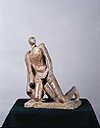
 |
Belgium Forever Belgian self-consciousness was fragile even before the German invasion. As a result of ideological conflicts, but above all due to the separation of the population into two distinct language groups, a serious separatist movement had developed in the Flemish part of Belgium. Furthermore the Communists had played an extremely important role in the Belgian Résistance movement. This conflict found expression in the person of the King, who was accused of betraying the people by the Walloons. The Flemish, by contrast, saw in him the defender of the nation. There was therefore fear of a civil war after World War II. This was a further reason why the Belgian government tried to use the remembrance of the War as a patriotic bond for the nation between 1945 and 1955. It was especially the suffering of the inhabitants under German occupation that was utilized for this purpose. The bad Germans were contrasted with the good Allies, and the Belgians were classified either as helpless victims or as the happily liberated, depending on the need. Belgium was to be understood as the country of unanimous resistance. In the narrative memory of Belgian resistance it was less about concrete heroic deeds than about a "mental readiness to fight shared by all Belgians" as well as the broadest possible interpretation of resistance which would embrace all of the different Résistance groups. |
| The conflict about the return of King Leopold III to the throne expresses the irreconcilable positions between the Flemish and the Walloons. The Walloons attempt to discredit the King with this poster. They show his "voluntary imprisonment" in occupied Belgium as a time of personal happiness. A prisoner of war – the King had promised to share the fate of his soldiers in everything – has to stare at the happy couple from behind barbed wire. The royalist block, on the other hand, postulated that the King had ended the human drama of the war through capitulation. | |
| The notion of mutual suffering is also the focal point of the Fort Breendonk national memorial, which was opened in 1947. The sculptor Idel Ianchelevici took up this idea in his monument to the Résistance from 1954 and added the idea of fighting back. His hero, shown here in a smaller replica from 1970, cannot be called a soldier, because he is unarmed. Although he has been forced to his knees, his back remains unbowed. He is about to rise again. Ianchelevici has found perhaps the most heroic image of the Résistance here. | |





